Nieman Storyboard
The intersection of storytelling and technology, a publication of the Nieman Foundation at Harvard University.See all my essays at Nieman Storyboard

What's the Buzz?
Monkeying with Story in the Hive MindThe idea of the hive is both terrifying and compelling — terrifying in that we don't want to lose our individuality, yet compelling in that we often yearn to be a part of something larger than ourselves. These contradictory desires are both old and deep in us. Different eras may have striven for one over the other, or have had different levels of awareness about the pushes and pulls, but the struggle predates the biological metaphors we use to explain it, and it certainly predates any informational metaphors we've come up with since.
I don't think the hive is minded. I've sat in enough meetings to know that fruitful collaboration is the exception, not the rule. But — something is happening; something is different about our era, and that something hinges directly on our technologies of storytelling.
Continued on Nieman Storyboard

How I Learned to Stop Worrying and Love the Flow
Cellphones and the etiquette of the expanded selfNothing prepares you for your first time.
You're out with someone, maybe a date, maybe just friends, everything's fine, and then he whips it out, right in front of you—at a restaurant, on the street, anywhere. You try not to look at it, you try to look absolutely anywhere else—finally he finishes and puts it away and continues on with the conversation, just like nothing happened. Or maybe he airs it out for awhile, or even—casually—holds onto it, in case it vibrates.
You know, the phone.
Continued on Nieman Storyboard
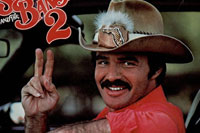
There's No App for That
CB Radio versus TwitterEverything is moving too fast, and there’s too much of it. No one has time for anything except the "app": that little predigested package with soft rounded corners, popping up with a factoid, and then disappearing again with a click. What the app is meant to do or say almost doesn't matter, as long as it's fast. That's our working assumption; it's common sense, it's understood: everything's too much, everything's too trivial, everything's too fast. We're stranded in the shallows and are gasping for depth. Yes, that's how our world is. Yes, those are our problems.
But what if it isn't? And what if they aren't?
Continued on Nieman Storyboard
back to top
Berfrois
Berfrois is a literary-intellectual online magazine, edited by Russell Bennetts.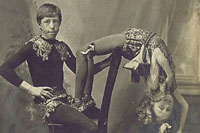
Short Attention Span Theater
What vaudeville has to teach us about the benefits of multitasking.Short attention span theater is hardly the new kid on the block. In the vaudeville era, an act was viable if it could manage to keep the audience's attention for three minutes. Three minutes! That's a span we understand — approximately the length of the average YouTube video, or a pop song. And if three minutes seems too long, that’s OK. We have Twitter.
Continued on Berfrois
back to top
See all my essays at HiLobrow.com
HiLobrow
I was the first virtual Artist-in-Residence at HiLobrow dot com, after which I became a regular columnist on the arts and technology, then Arts Editor.See all my essays at HiLobrow.com

Spacetime Bandits
Where you are depends on when you areThere’s a fascinating recent trend in art about place that takes an almost fractalized approach to size. By scaling the work down—way, way down—it turns out that it has as much potential for complexity and meaning as the previous era's scaled-up offerings. One might call it locative art, or walking tours, but the trend encompasses more than text and audio, and involves more than virtual incursions into physical environments, or GPS. And it turns as much on time as it does space.
Continued on HiLobrow

Of Age
At the close of the Heroic Age dawns the Age of the CommuteThe great discovery of our Age is: it's not what we can discover, it's what we can make of it. And this making-of is an open-source, democratic creativity. The playfulness is necessary to get us thinking outside of boundaries long etched in our assumptions. And in the play of imagination and the redrafting of boundaries, we might create new worlds. The ones the next Age might discover.
Continued on HiLobrow

Eloi and Morlocks
The artist versus the day jobHey! I bet you're wondering how an artist makes a living, especially when I don't make anythings. I have a day job of course. I design patterns in software to enhance emotional reactions, which in turn enable businesses to run more like machines. I get paid to build utopia—but not for you. Or for me: for them. I work in IT.
Continued on HiLobrow
I, Avatar
We're all mutants. And that's good!We have always had virtual selves, from the minute we imagined anything not in the immediate vicinity, or the other minute when we remembered the location of the winter cave. The minute the future and the past arrived, the minute we drew an arrow or a hand with three fingers on a wall, the minute we spoke, or otherwise communicated to, another being, was the minute we became virtual. I don't mean the mind/body problem. I mean the mind is the body's problem, the virtual is literally, physically, real. And we manipulate both when we manipulate one.
Continued on HiLobrow
back to top
See all my essays at Brattle Theater Film Notes
Brattle Theater Film Notes
Film essays for the historic Brattle Theater in Cambridge, MASee all my essays at Brattle Theater Film Notes

Project Nim
"What we have here is a failure to communicate." Or, do we? In the documentary Project Nim, director James Marsh reexamines the well-publicized attempt by Professor Herbert Terrace, a behavioral psychologist at Columbia University, to test whether we can talk to the animals. Nim Chimpsky, his name a play on the linguist Noam Chomsky, would be taken into a human home and raised as one of the family, exposed to all human forms of communication, verbal and nonverbal, while being taught sign language.Continued on Brattle Theater Film Notes

Grizzly Man
Werner Herzog is uniquely positioned to tell this tale. Throughout his prolific career Herzog has been fascinated with extremes—of man, of nature, of the lengths to which we will go to find meaning, substance, wonder, or the fabled far edges of the earth. By mapping the negative spaces of extremity, Herzog has shown us in ever-sharper outline what it means to be human, what it means to be wild, and what it might mean to be free. And as well he has an eye for the absurd, for in the seeming contradictions of our behavior and beliefs often lies the key, not to what we make of it all, but what we all might make of each other.Continued on Brattle Theater Film Notes
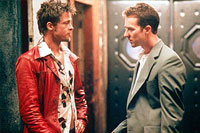
Fight Club
Culture-jamming is often, although not necessarily, political. But the culture-jamming of Fight Club is most definitely political. A hard-nosed socio-economic critique wrapped in a mystery inside a comedy, the implications will stay with you long after you leave the theater. The critique reaches both "out," to the financial system and the culture at large, and "in," to what you feel, why you act, and who you think you are.Continued on Brattle Theater Film Notes

It's A Wonderful Life
The film tells the story of George Bailey of Bedford Falls, a stand-up guy played by incomparable everyman Jimmy Stewart, who has devoted his entire life to his family, his business, and doing the right thing, to the exclusion of his own ambitious (and perhaps unrealistic) dreams. How's that working out? As the story opens he's 40 and about to throw himself off the town bridge.Continued on Brattle Theater Film Notes
back to top
OtherZine
OtherZine is the companion film journal for Other Cinema, a venue for experimental film, video and performance in San Francisco run by filmmaker Craig Baldwin.
Lars and the Real Gif
Animated gifs are backPratfalls and abrupt motions are the result, not of a graceful animal, but of a crude robot unable to adjust quickly enough to a change in its environment; in other words, us. Slapstick is us acting like a machine; we laugh at the gaps and the hapless repetition. The embedded humor of the animated gif points to the features and limitations of our technologies of art-making, and suggests that those features and limitations may be, ultimately, the same thing.
Continued on OtherZine
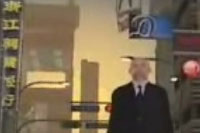
Deus ex Machinima
Making movies in game-space: a review of fanfilm, machinima, and the ultimate high score.Building a world, by film or other means, seems to be not only about individual or group expression, but about this strange impulse we have to copy everything. Our art so often involves duplicating aspects of our world: novels, realistic painting, photography, film, virtual worlds, video games. An enormous amount of time and energy is spent on making things more realistic; visually, physically and psychologically. What is the impulse for these ever more elaborate copies? What do we get out of them? And where might they be leading?
Continued on OtherZine

Who is Bozo Texino: An Interview with Bill Daniel
The secret history of hobo graffitiA name, perhaps a face. A few lines, sketched on the side of a moving train. It goes by fast, but you have to look closely to see them: a different set of answers, to a different set of questions. Get ready as it passes through your station, not stopping, but slowing enough for you to jump aboard, into a strange past that's not present, a strange present that's not passed.
Continued on OtherZine

Potrait of the Artist as a young Indiana Jones
Interview with Chris Strompolos, producer and star of the cult hit Raiders of the Lost Ark: The Adaptation.I mean, I don't think we had any idea of the path that we were about to take, or how long it was going to take. Eric is funny, he says, "I thought I was walking into a situation where the sets were built, and the costumes were made, and lights were set up, we had a camera, a script was there, and we were all ready to go. All I would have to do is walk in and direct! Little did I know, the next 7 years of my life were going to be spent, just laboring away...!"
Continued on OtherZine
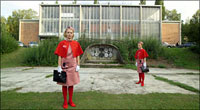
Pragmatic Utopias: Bata-ville
Sartorial standards for utopian tour guidesLet's design the perfect society. Why not? It will be a place where we will live in peace and harmony, where our work will be fulfilling and our leisure frequent, where an examination of our lives will reveal that they were in fact well-lived. A place where we will be able to declare our highest ideals and actually bring them into being without sullying their names. But, there are some practical things to take care of first, things like, where are we going to live, who are we going to invite, what are we going to wear? In other words, we need to talk about shoes.
Continued on OtherZine

The Rules of the Game
LARPing for lifeAfter a while, what feels real and what feels like role-playing can shift, and an immersive identity can seem more real, or at least more meaningful, than a day job in some office. A day job which, most of us have to admit, seems very much like role-playing very much of the time.
Continued on OtherZine
 HOME
HOME